The working environment for construction equipment is not perfect. Bulldozers, loaders, and excavators are often used and may be used in unfavorable environments. Wear and tear become a major issue as a result. Hard facing is another technique engineers employ to make sure gear lasts longer. Of all the materials used in the industry, tungsten carbide hardfacing is one of the most often utilized for hard-facing.
Tungsten carbide
Another name for tungsten carbide is a hard substance. Tungsten carbide is utilized in worn components, drill bits, milling machine tips, and cutting tools because it is more durable than steel. Because of this, it may be utilized in construction equipment where it must perform certain demanding tasks.
Why Use Hard Facing?
Hardfacing is a surface treatment technique whereby a hard layer is built on the surface of the part. This layer also offers protection to this part so that it may not be easily worn out or damaged. It is like providing a shield to a place that is always on the receiving end of pressure most of the time. This is achieved by the help of tungsten carbide hard facing which enhances the durability of these parts. It is used on parts like buckets, blades, and teeth, for instance.
Advantages of Tungsten Carbide Hard-facing
- Increased Durability: It is wear-resistant. It has the capacity to some extent to take some beating without getting worn out very soon. This means that the replacements and repairs will be effected after longer intervals of time.
- Reduced Maintenance Costs: If the parts used are more durable then the frequency of maintenance required is less in such cases. Less time is not wasted which leads to construction projects being delivered within the required time.
- Improved Performance: It improves the function of the machinery. For instance, a bulldozer blade with tungsten carbide is more capable of working on hard materials than on soft ones.
- Resistance to Extreme Conditions: Construction sites are typically very hostile. Parts can experience high impact, heat, or abrasion in their use. Tungsten carbide can endure these conditions and therefore the material can be used in a harsh environment.
How is Tungsten Carbide Applied?
The application of the tungsten carbide is known as hard facing. It involves several steps:
- Preparation: The surface is to be coated. This is to ensure that the tungsten carbide will stick well enough.
- Application: It can be applied using different methods. One common method is welding. In this method, carbide powder is melted and fused to the part’s surface.
- Cooling: The part is left to cool. This helps the layer to harden and bond strongly with the part.
Conclusion
Welding of Tungsten carbide is one of the most useful technologies that are used in construction machinery. They make the worn parts have a longer life, reduce maintenance costs, and generally improve the general performance. As for the tools that require high hardness and toughness in harsh environments, no other material can match the capability of tungsten carbide to work fast and efficiently. This is why tungsten carbide hard facing is important to construction companies because it assists in maintaining the machinery in good condition and working optimally in the worst of environments.

